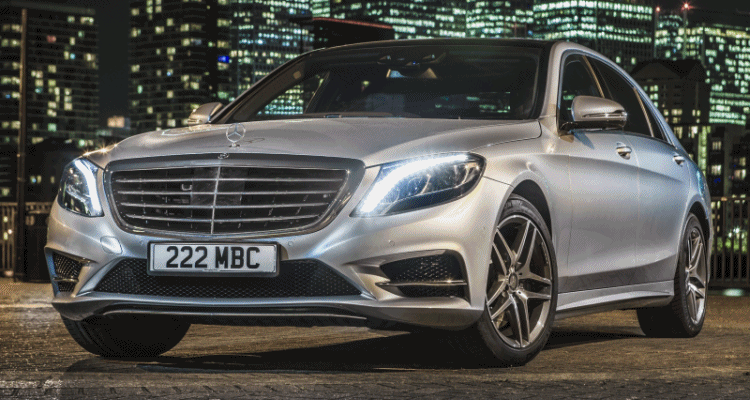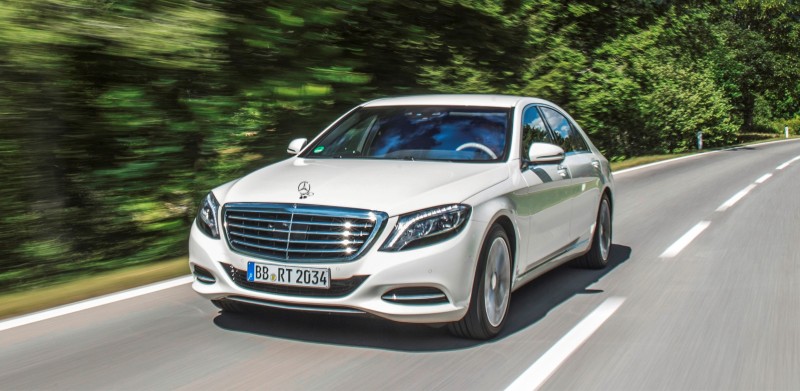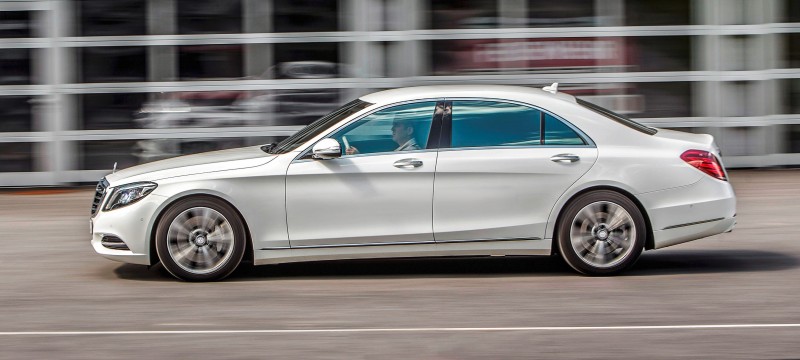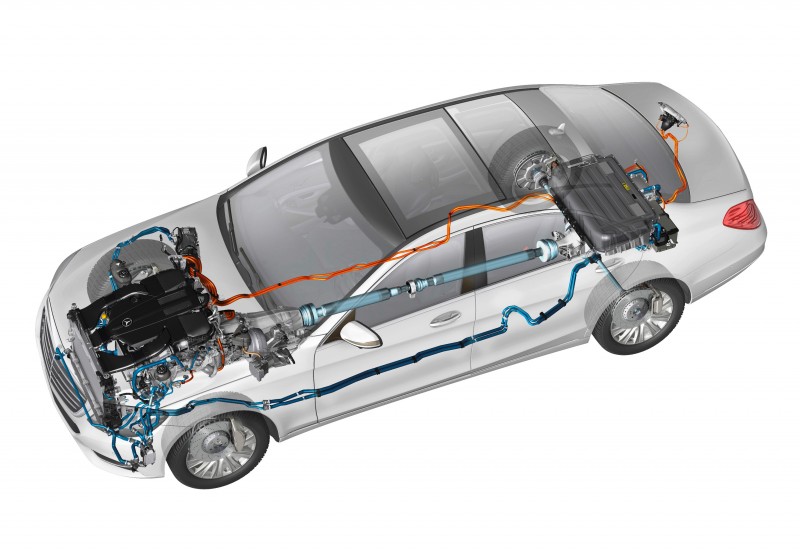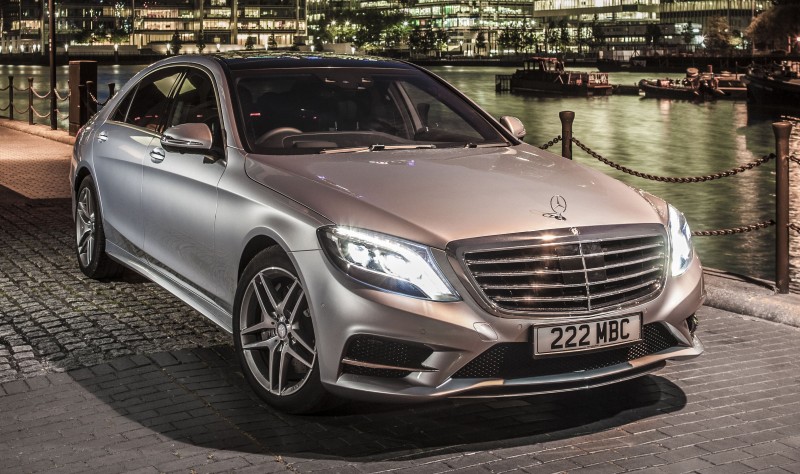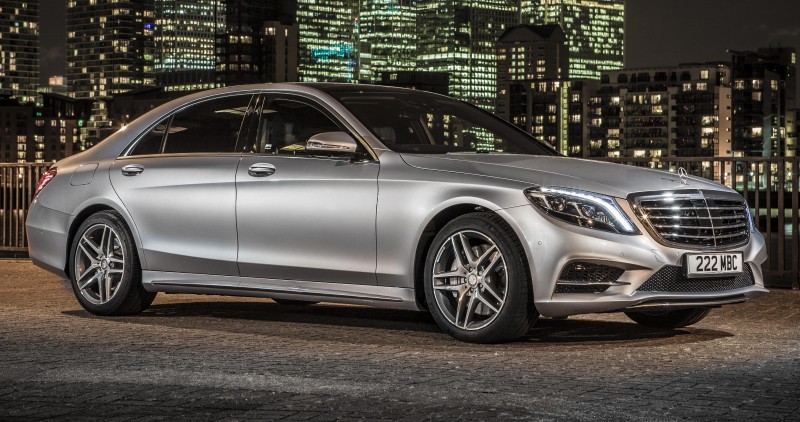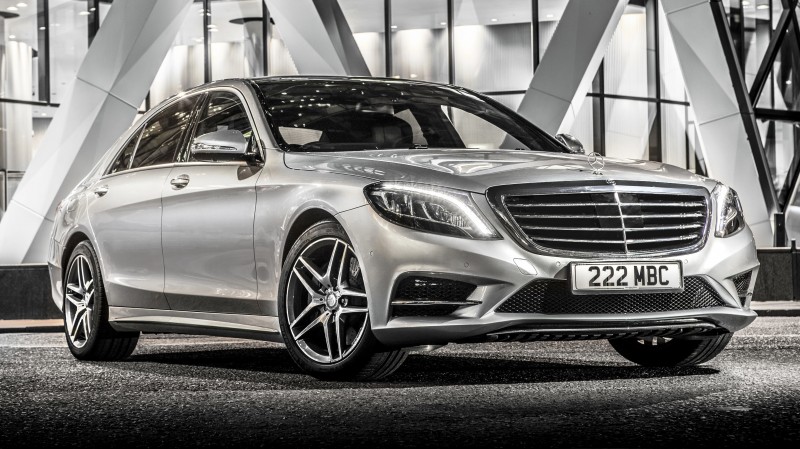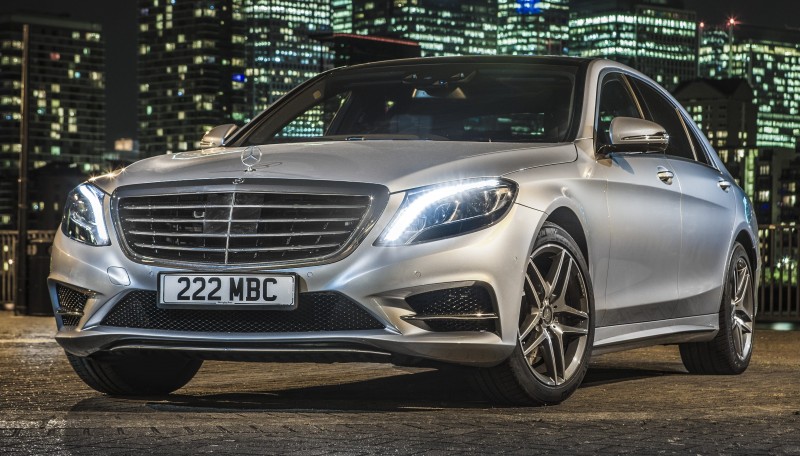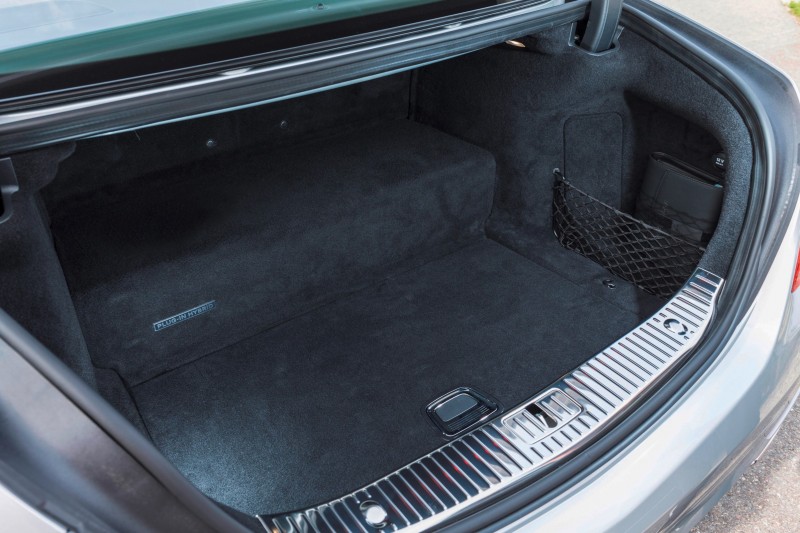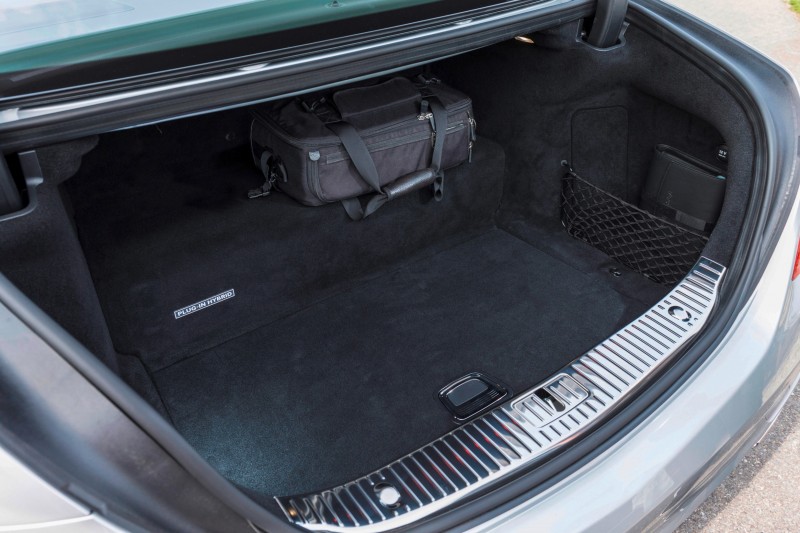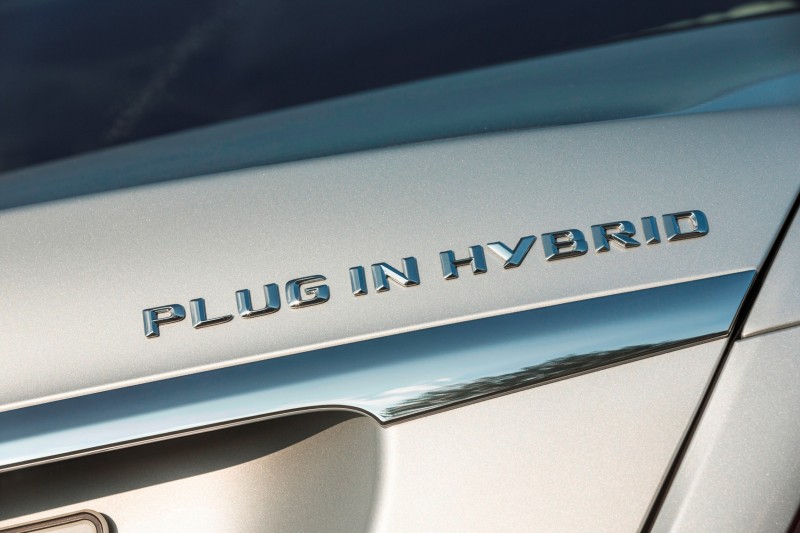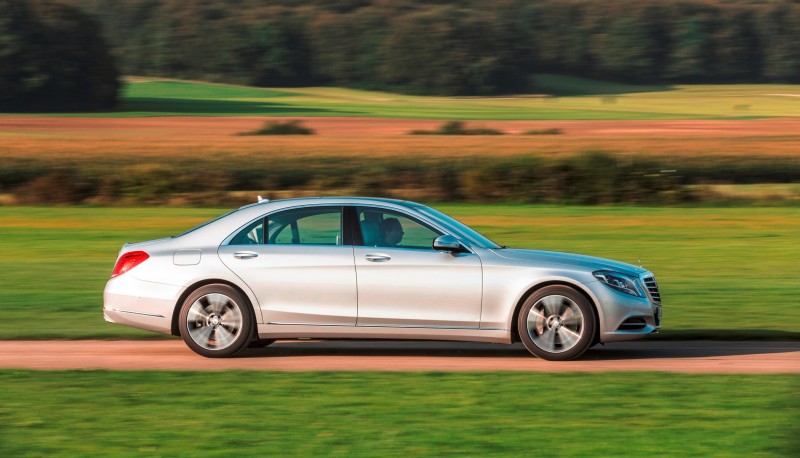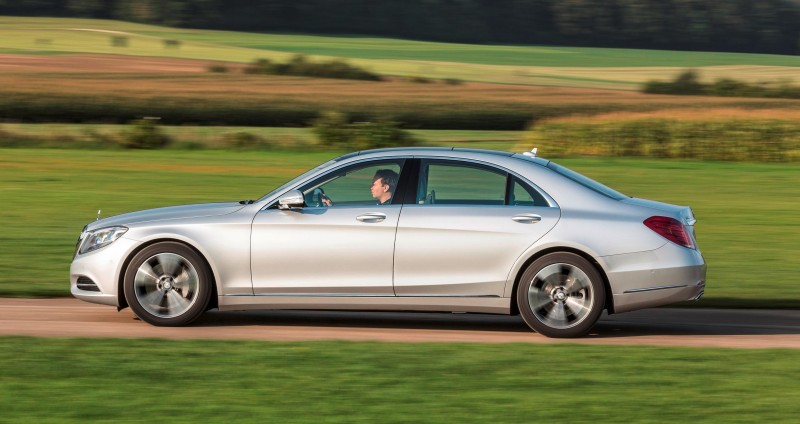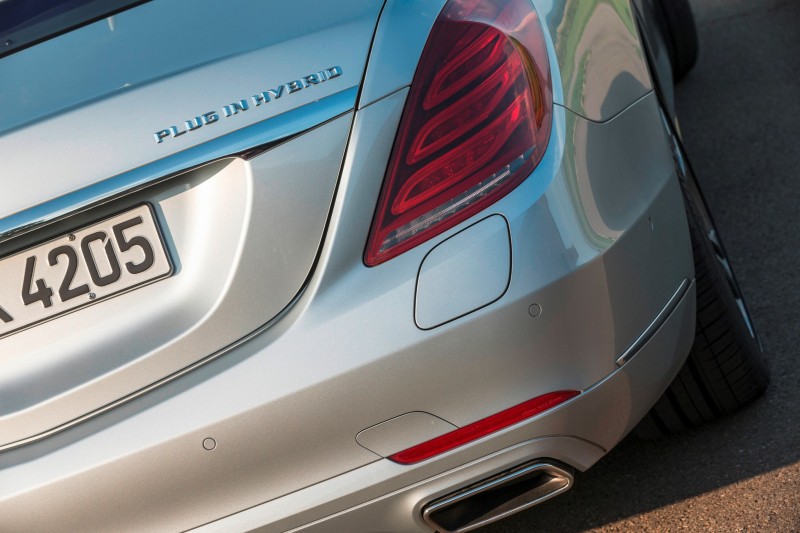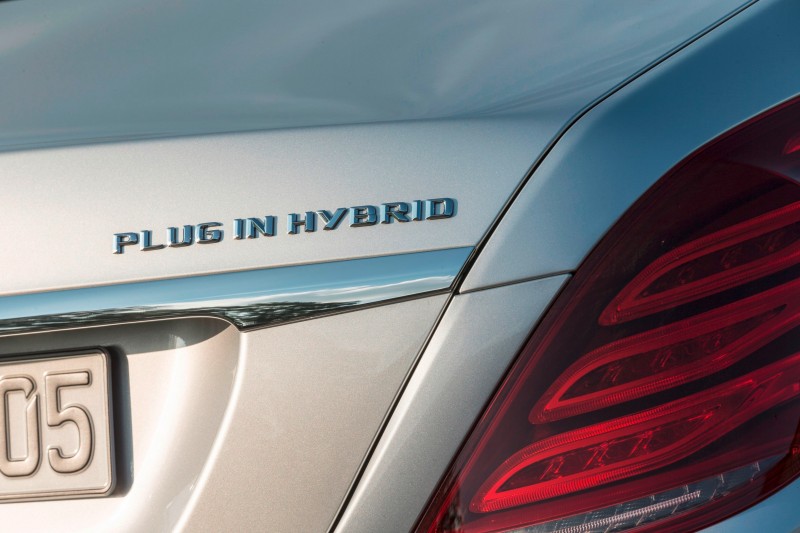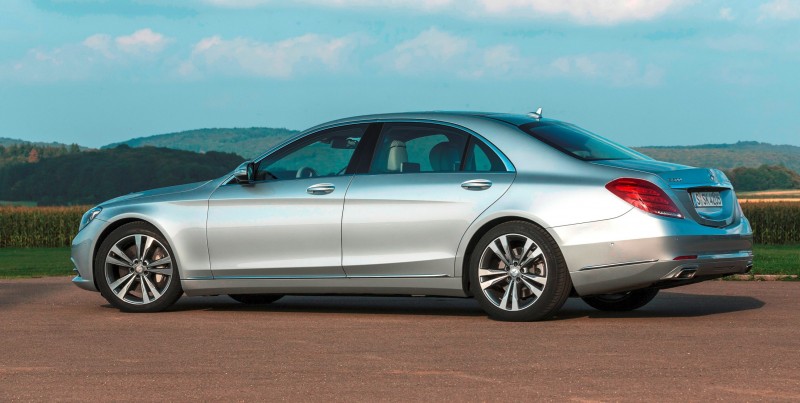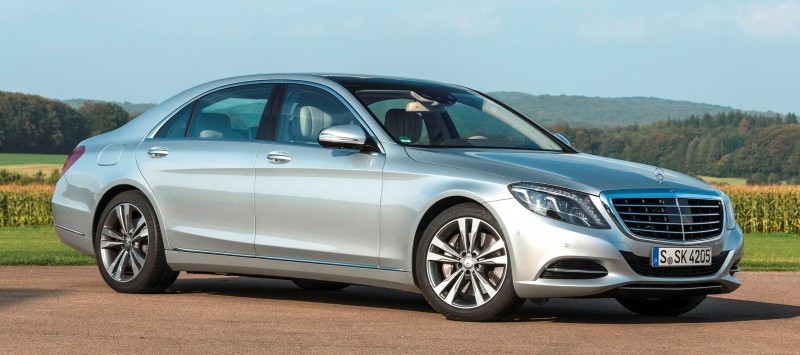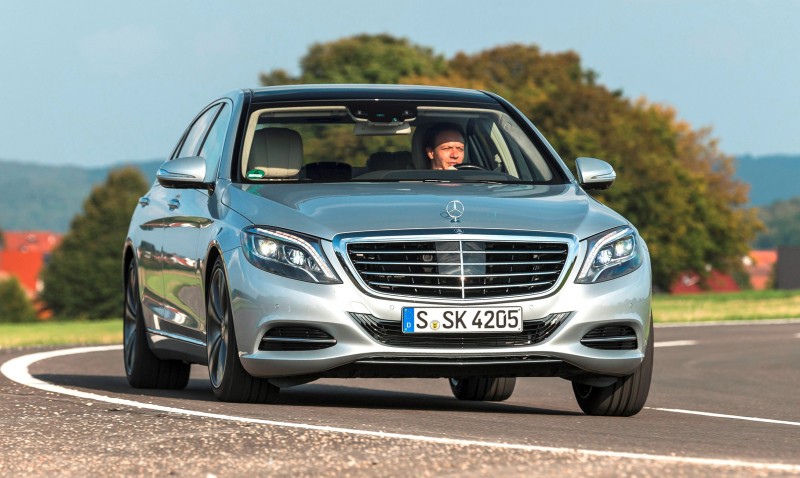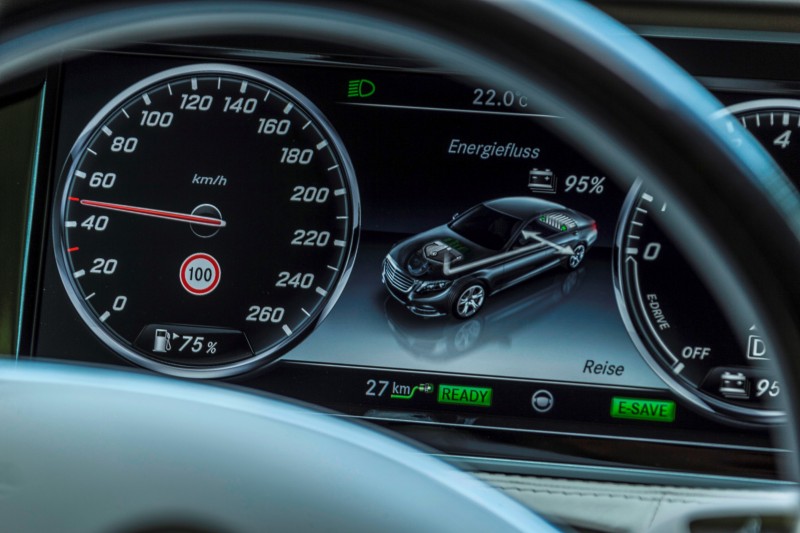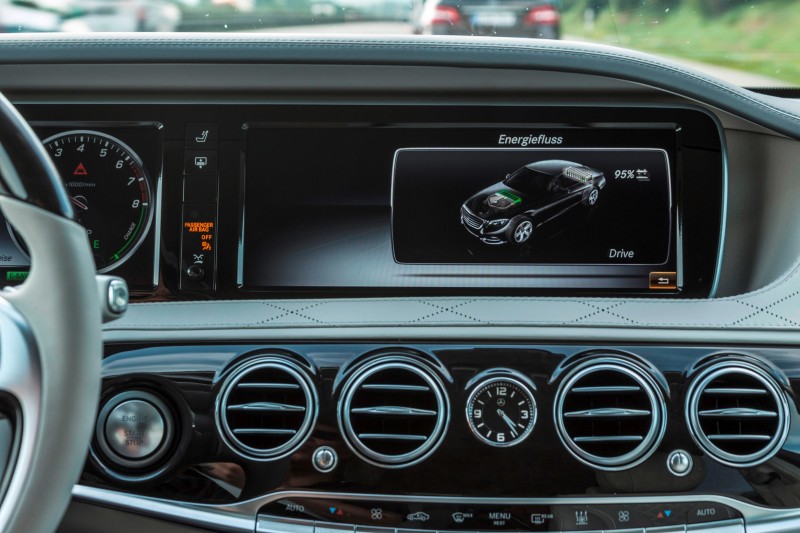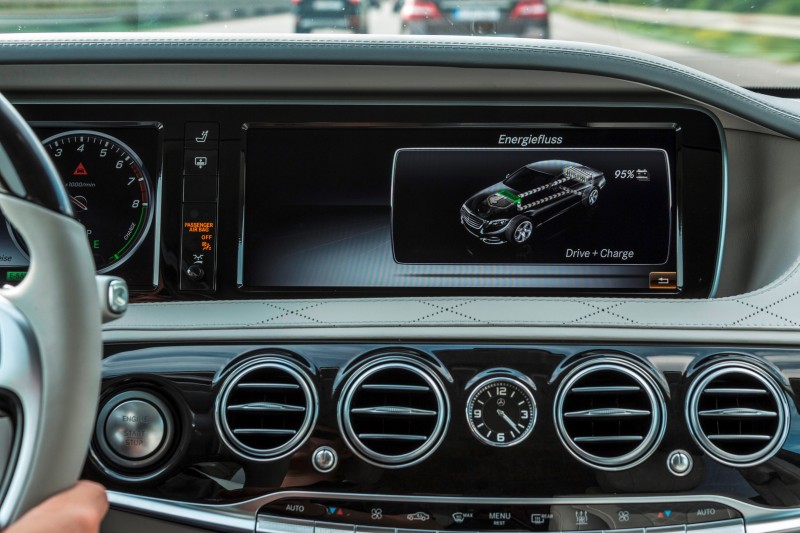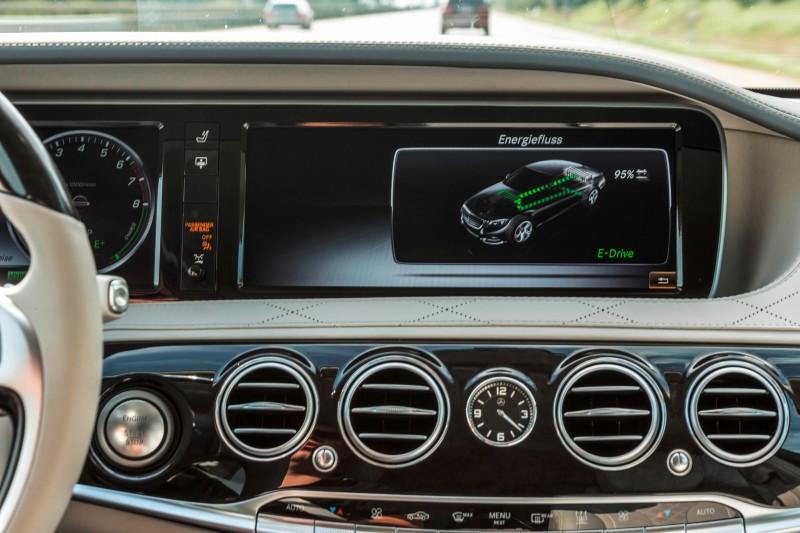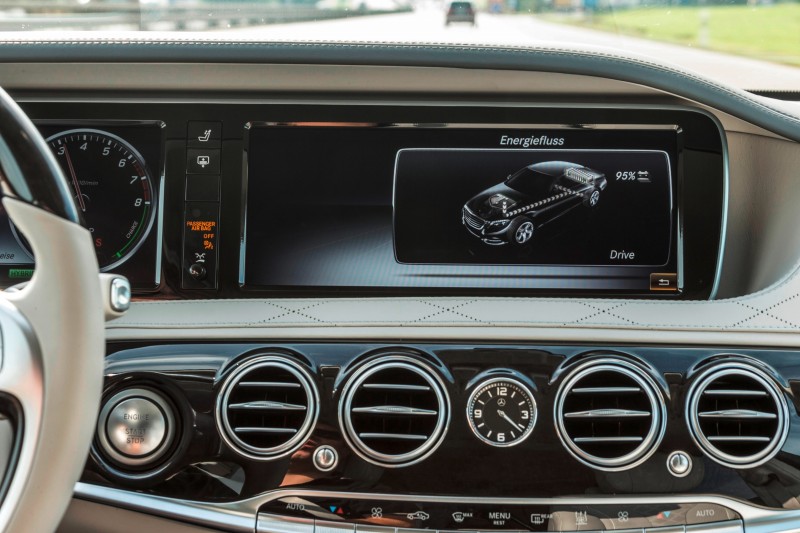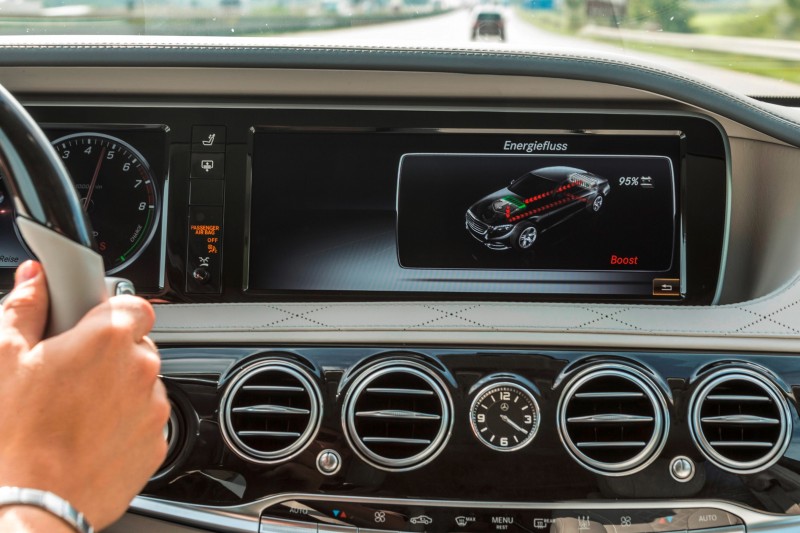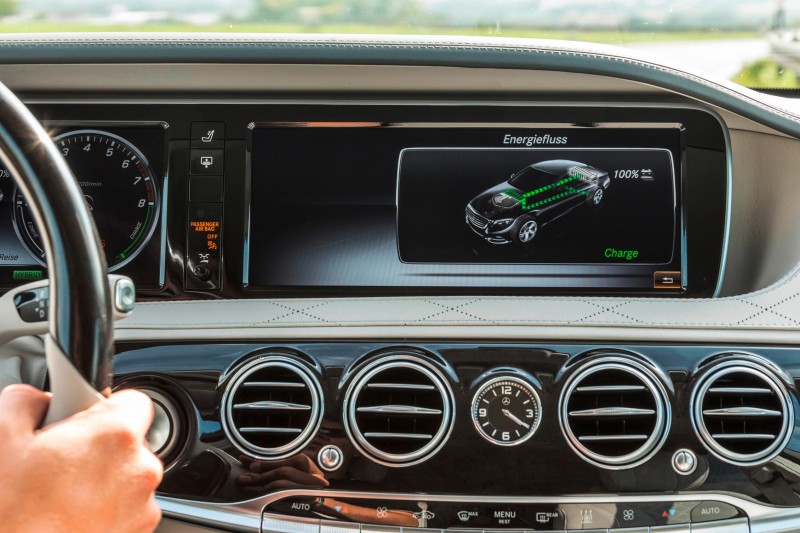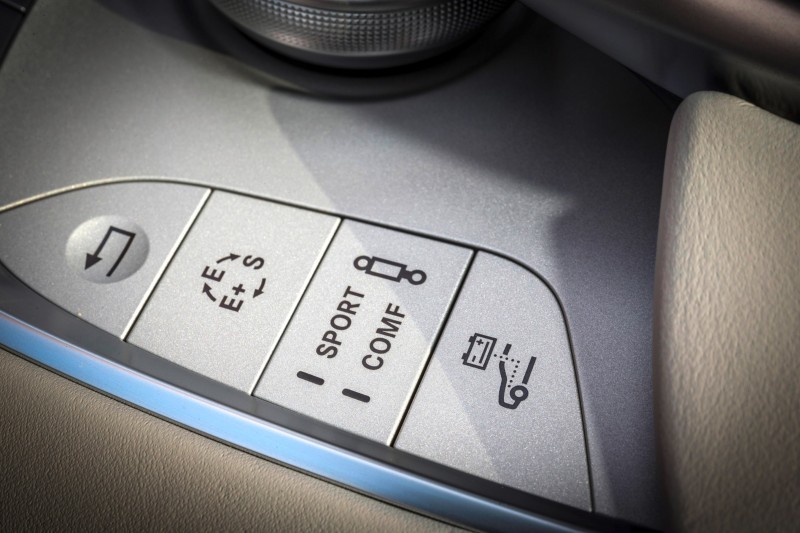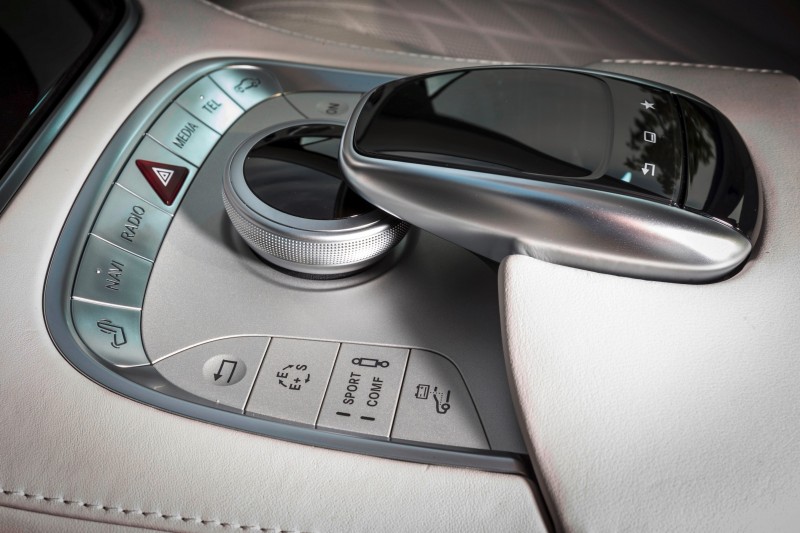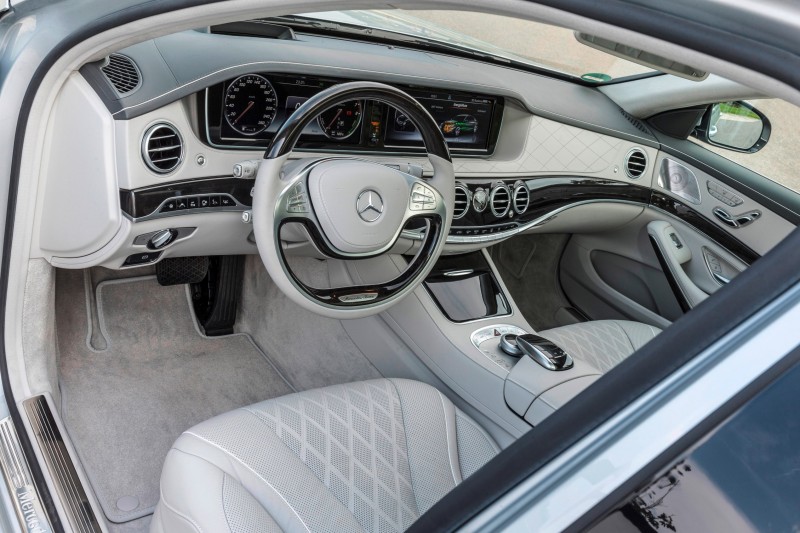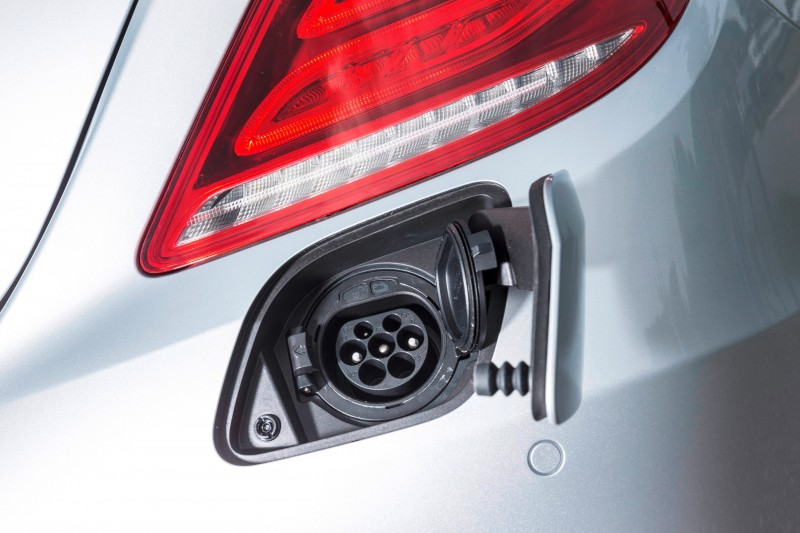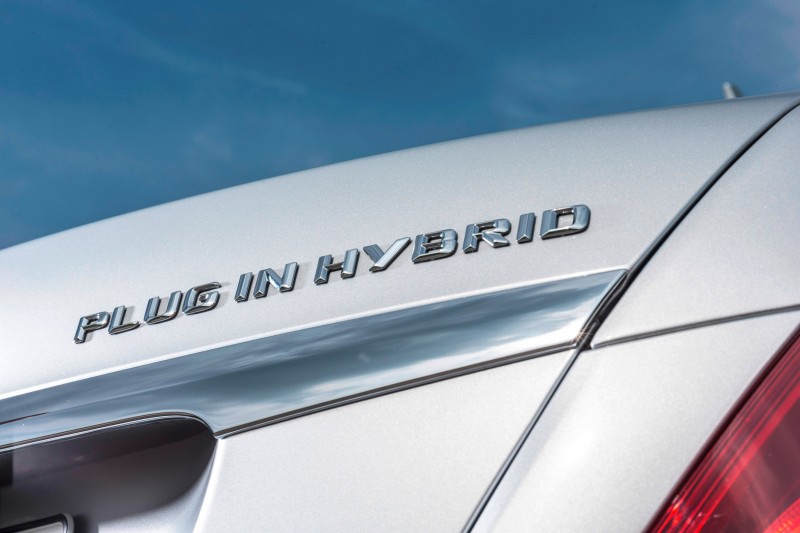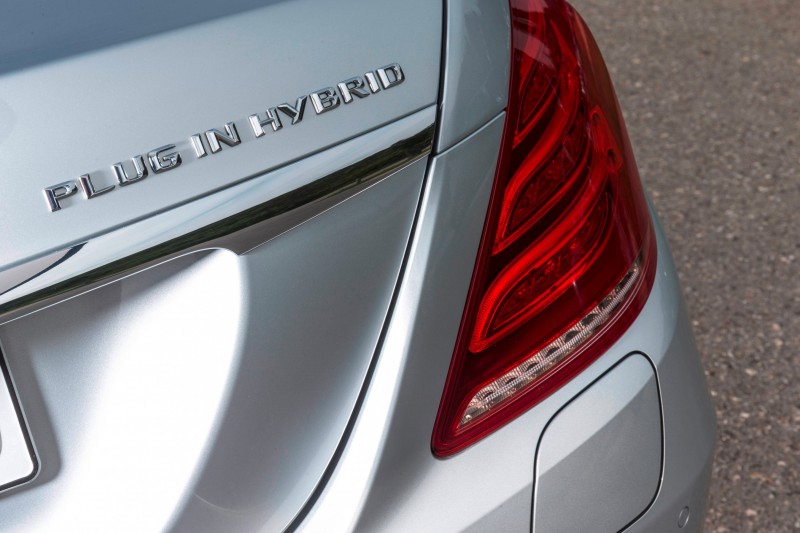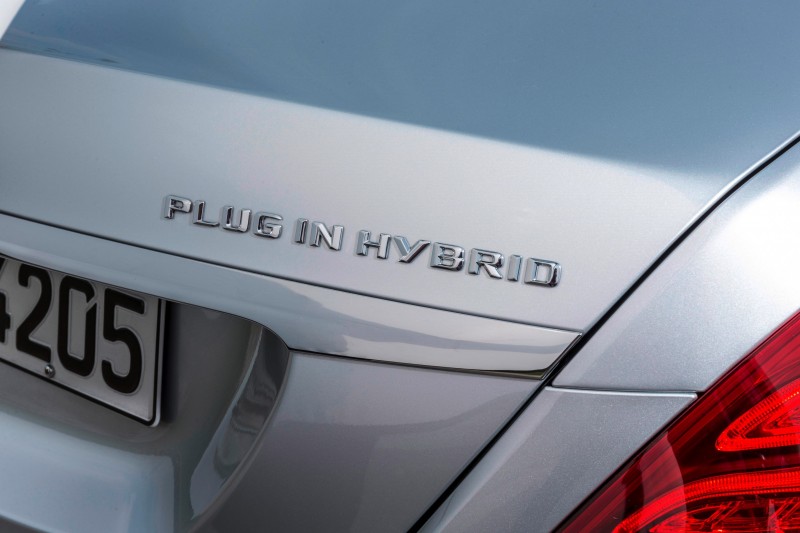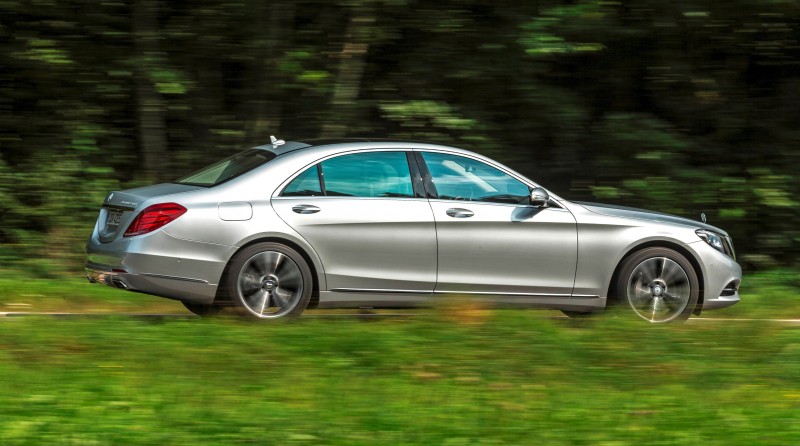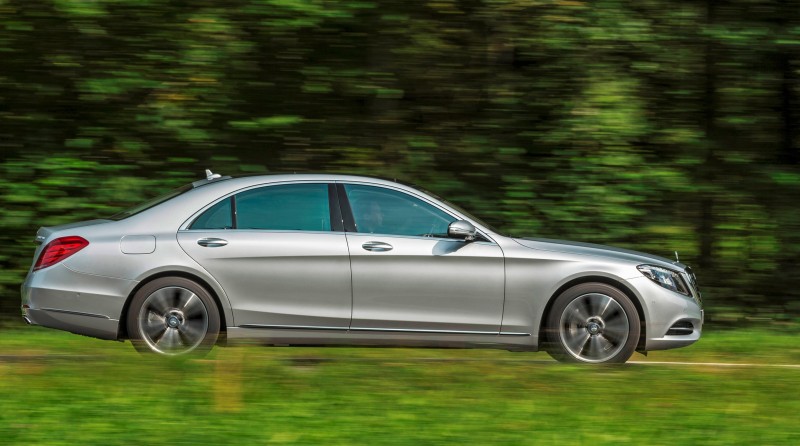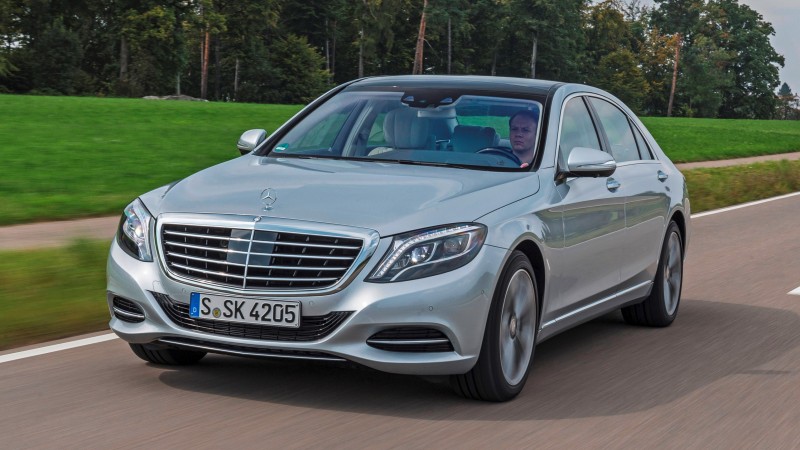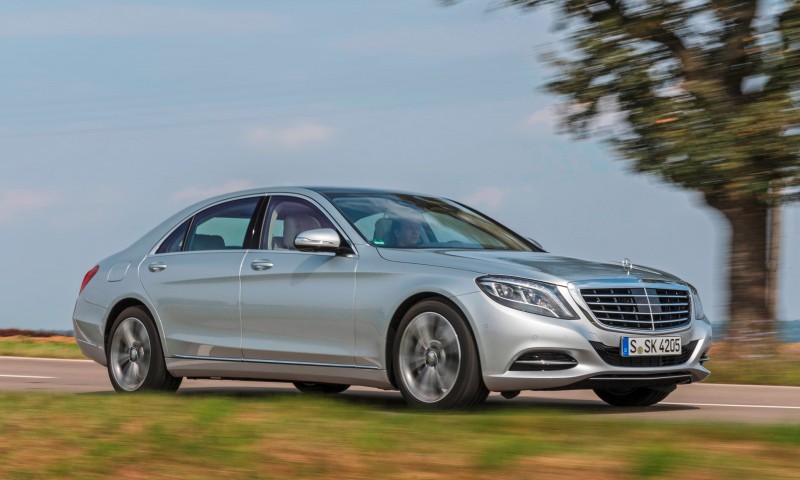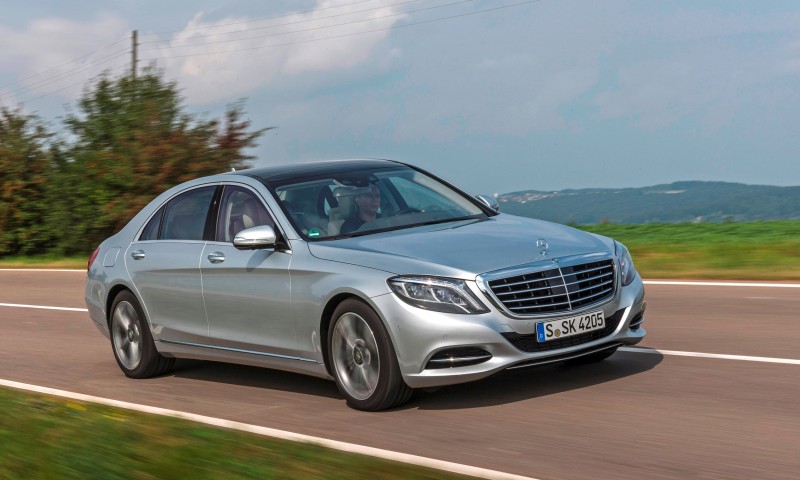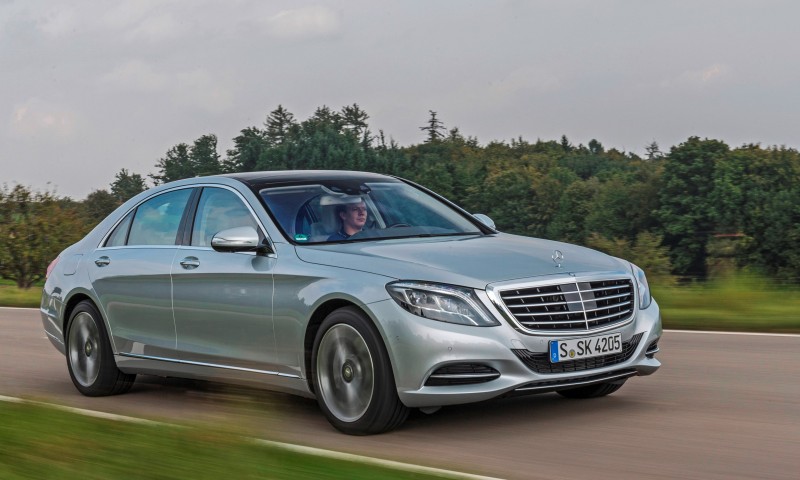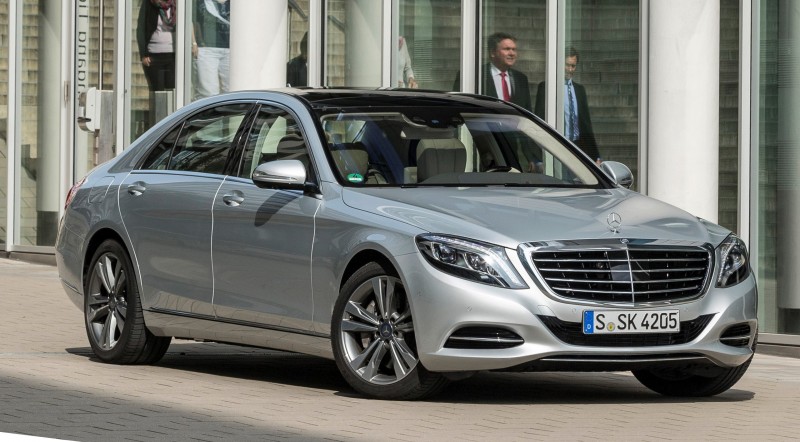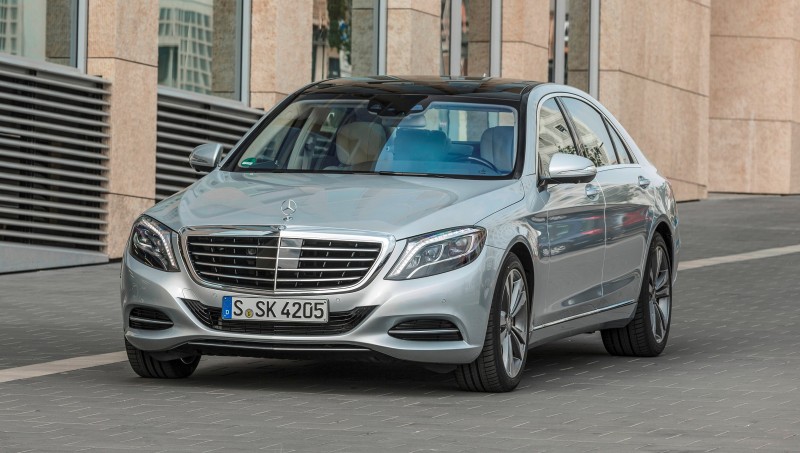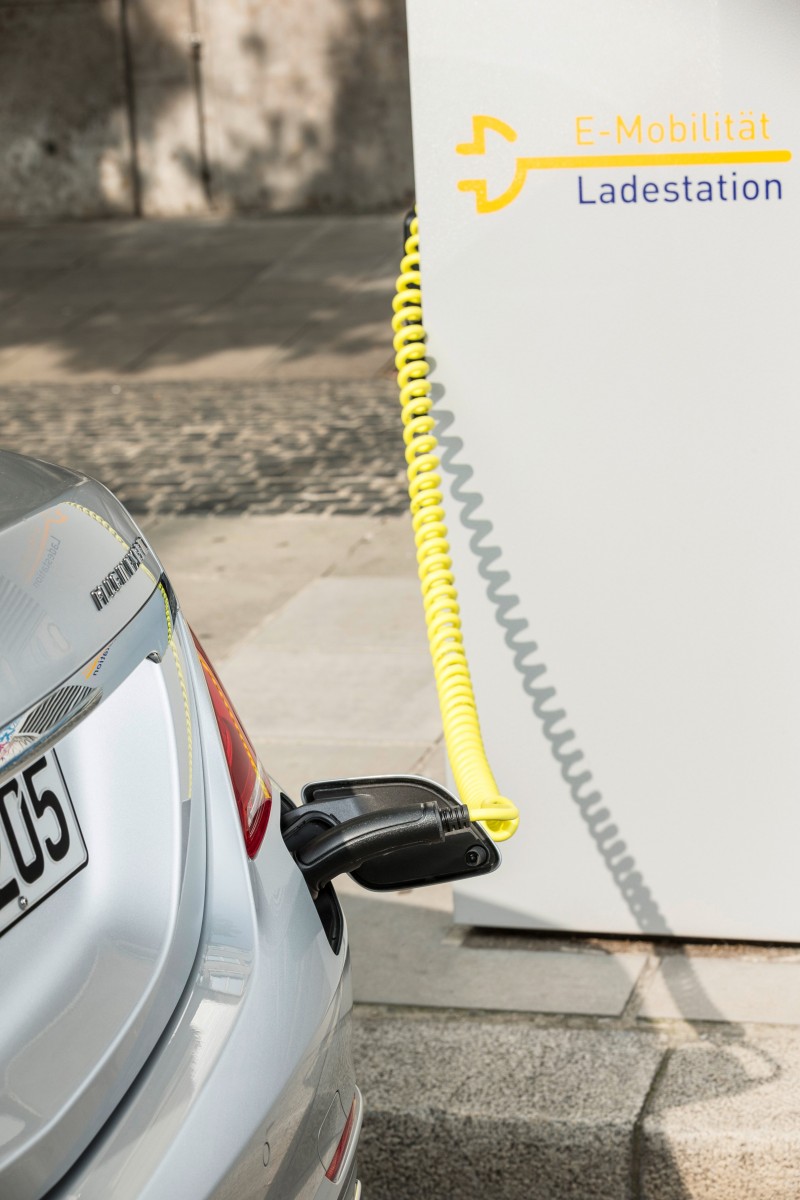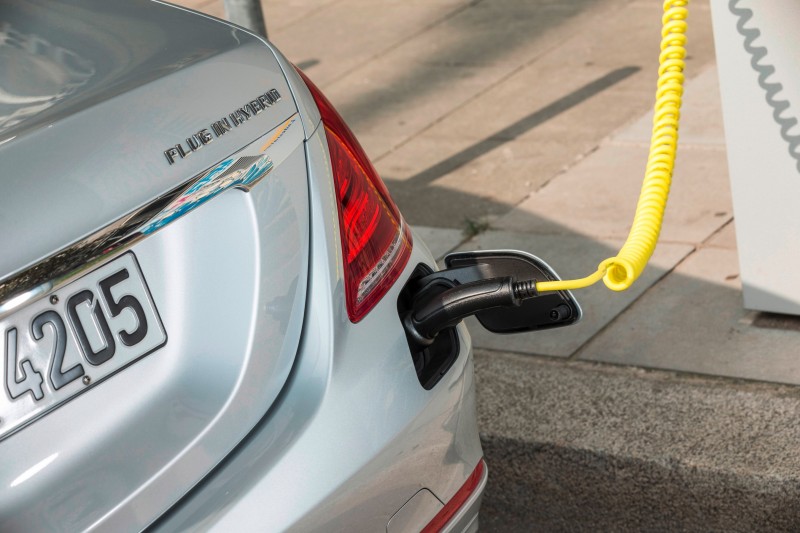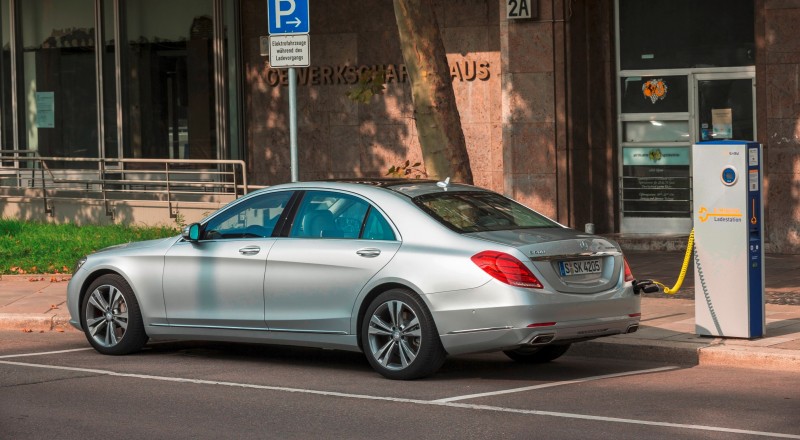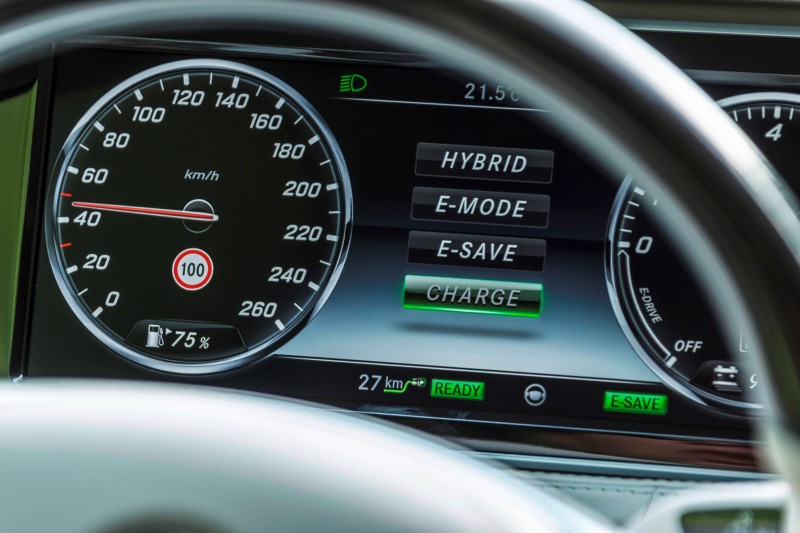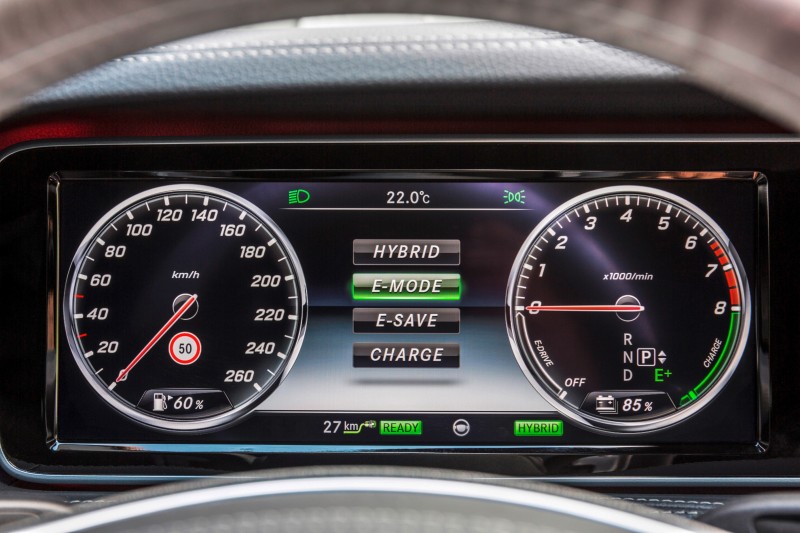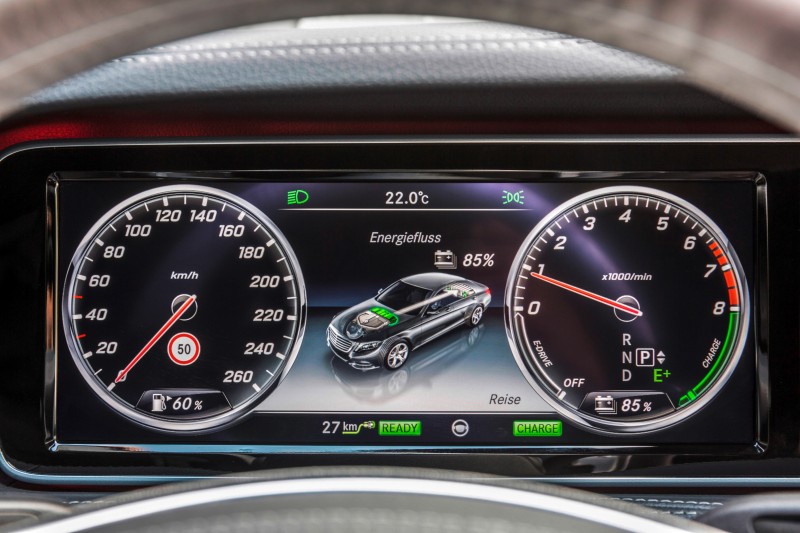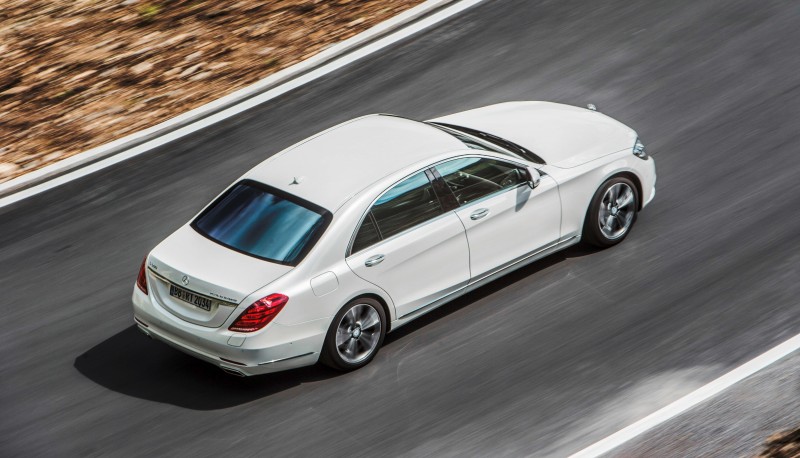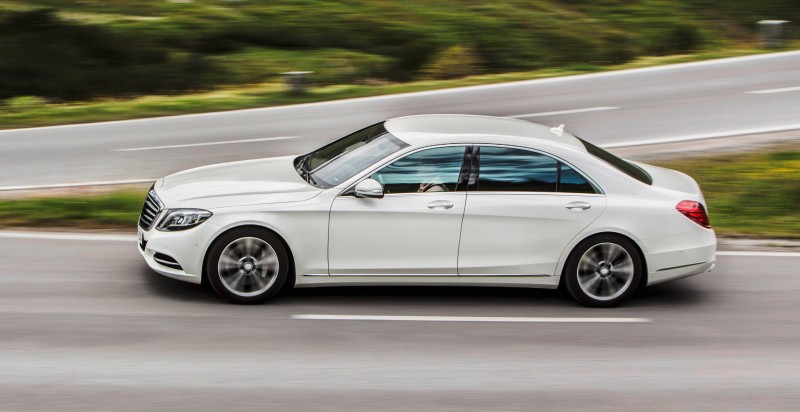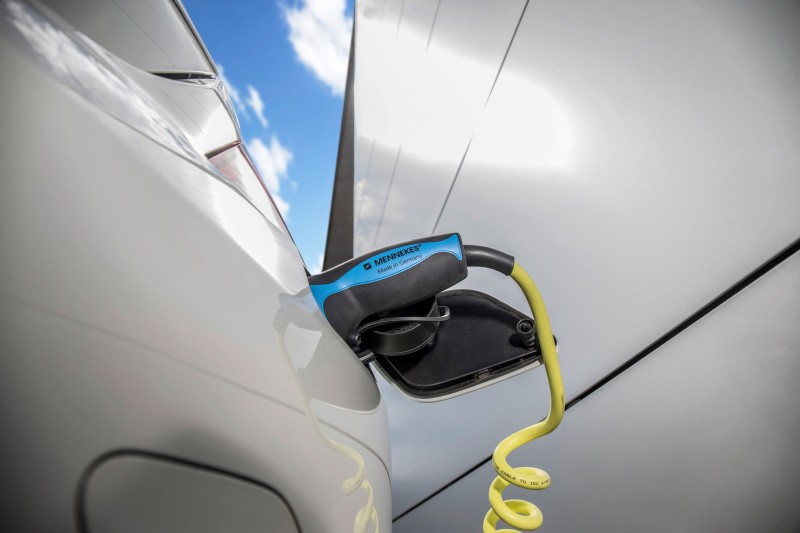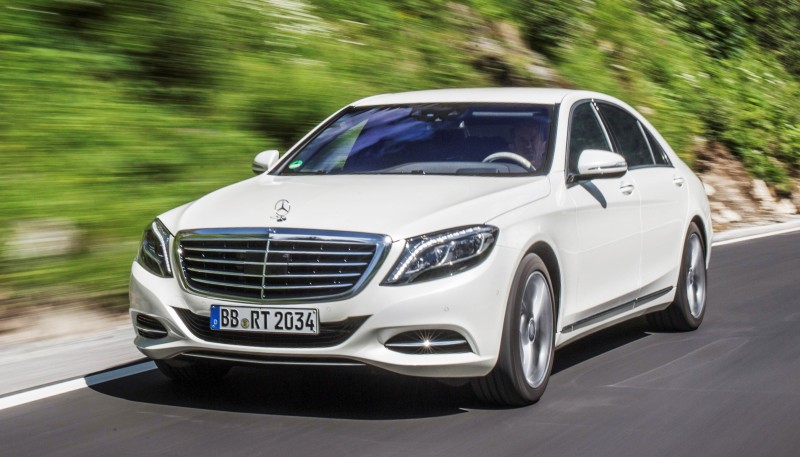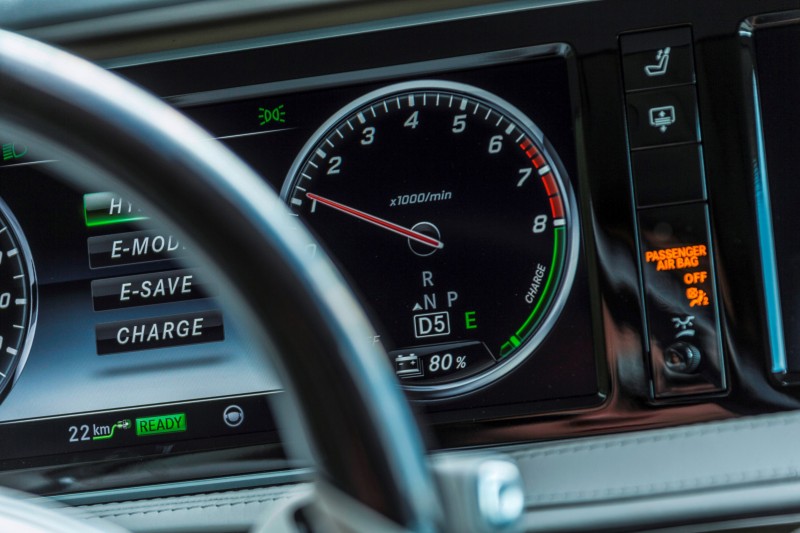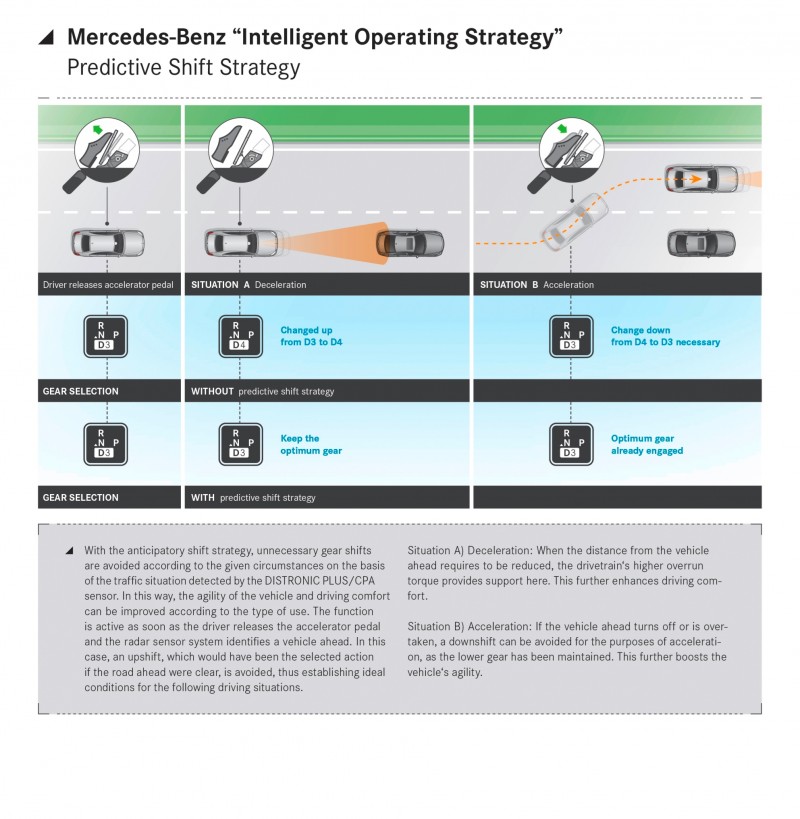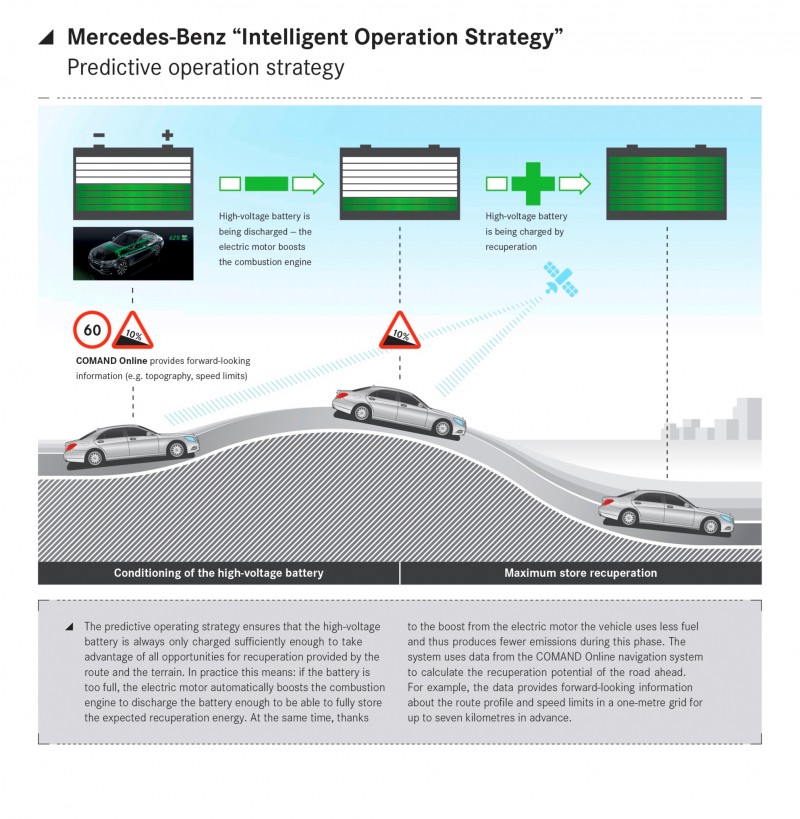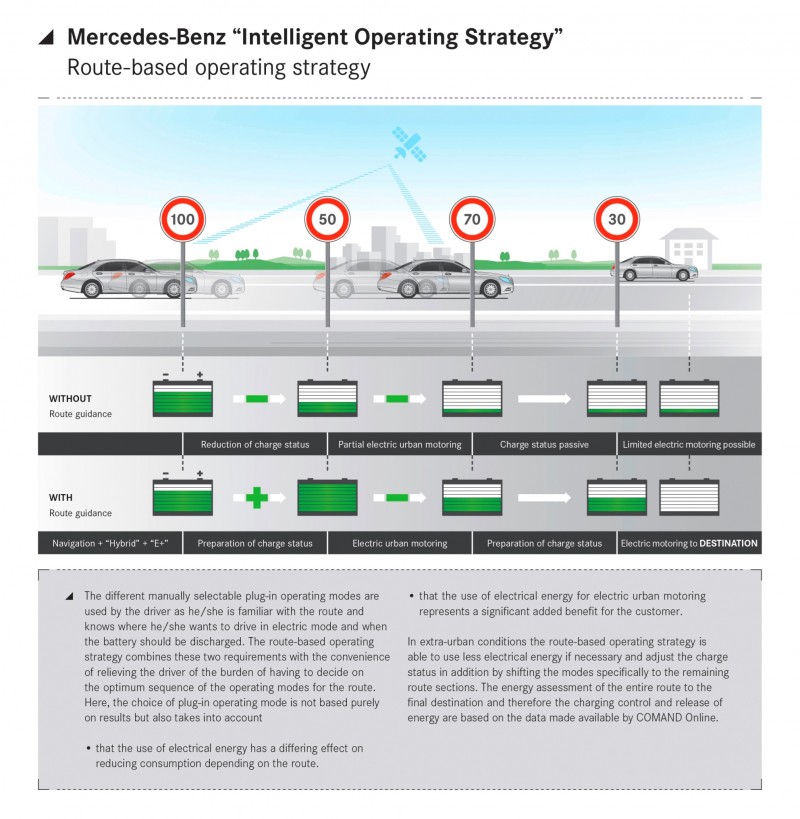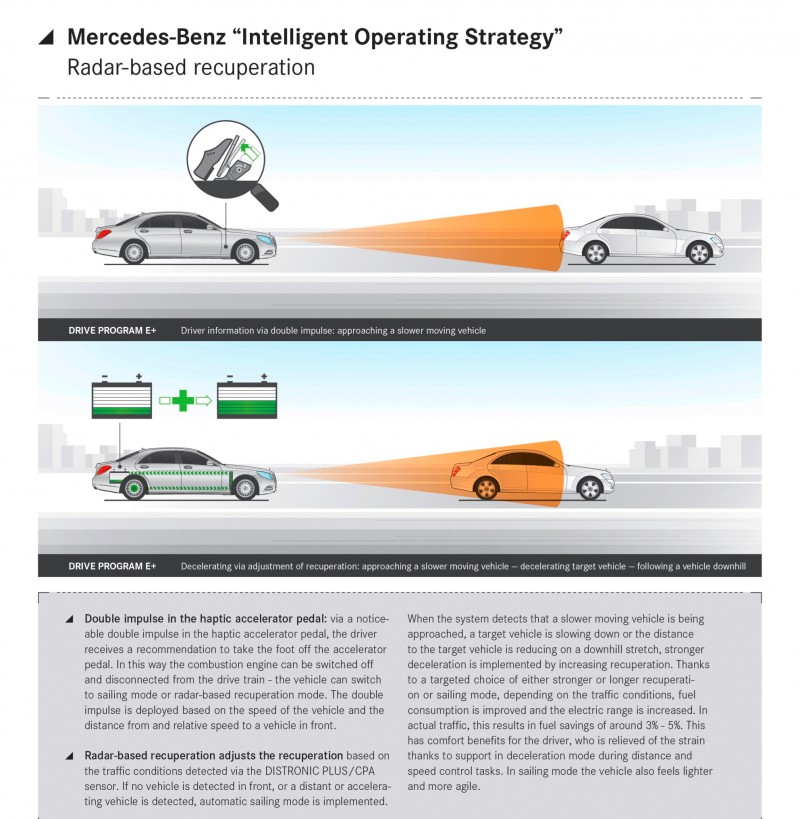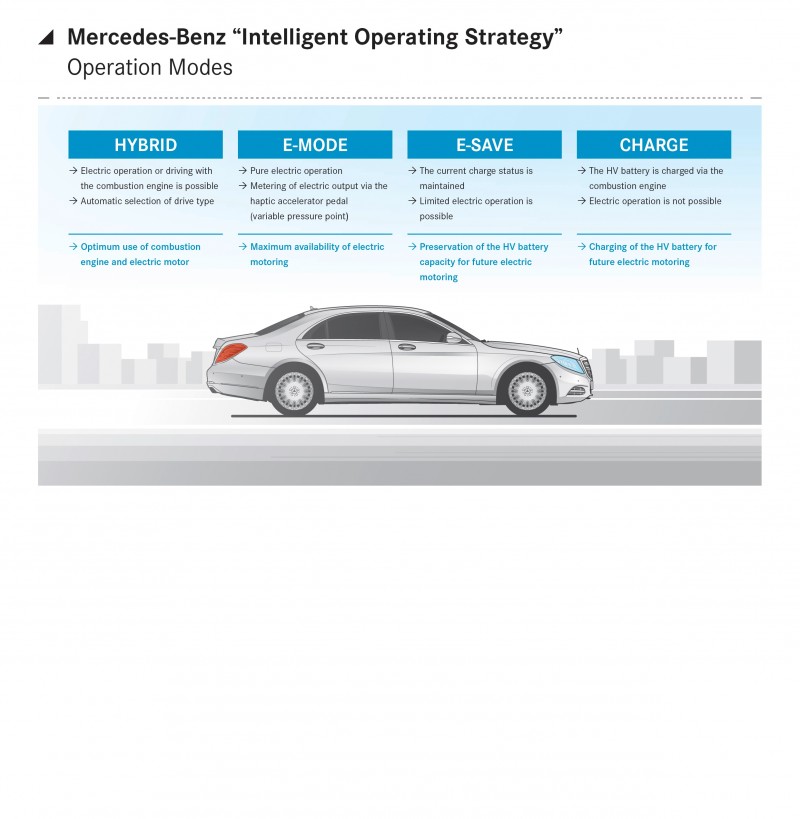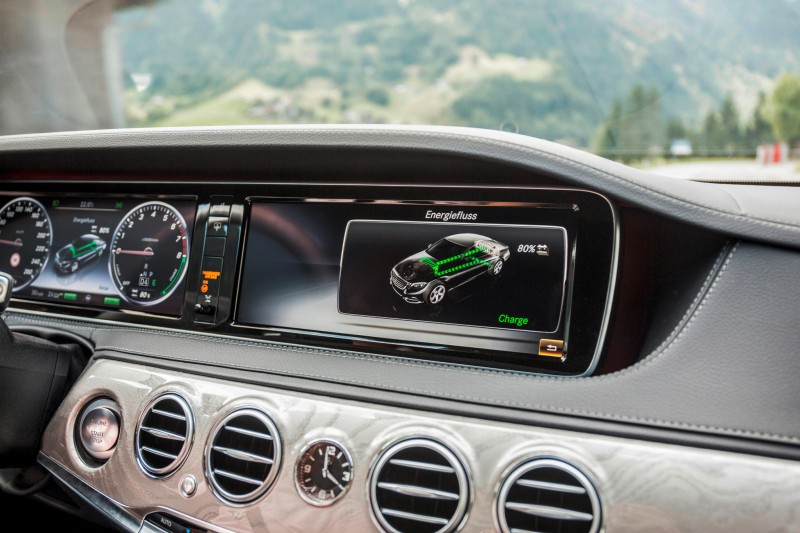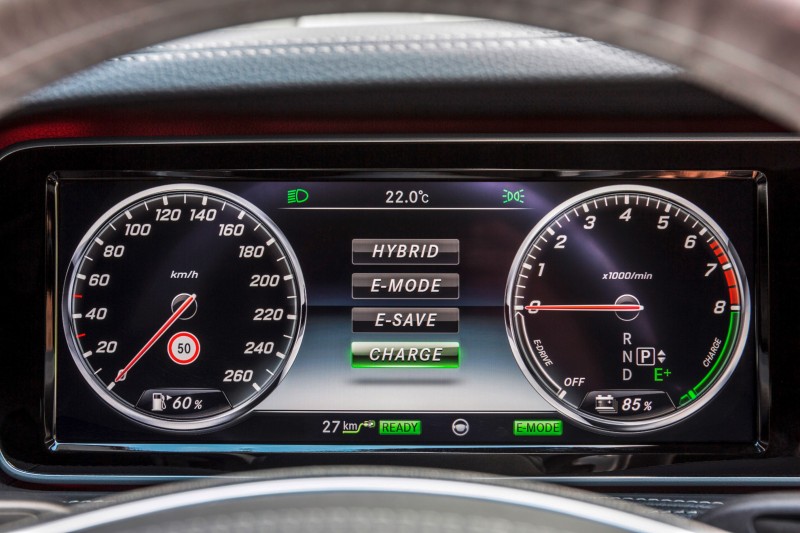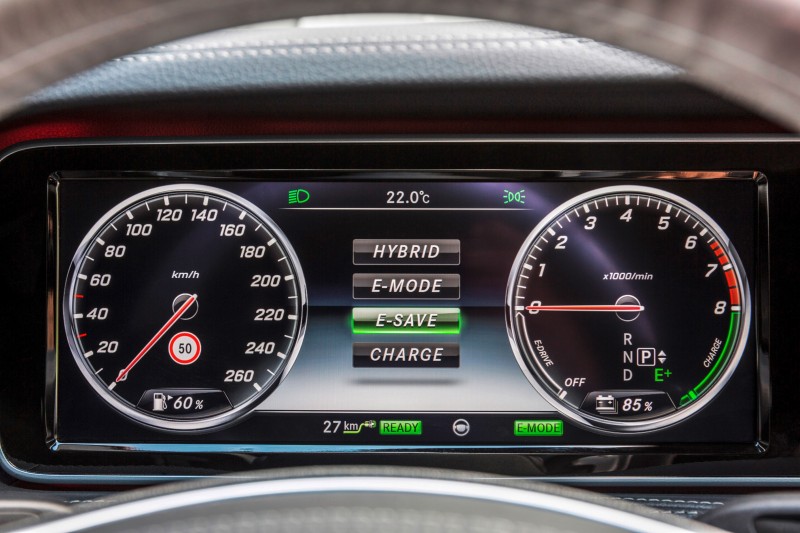It has taken more than two Hybrid S-Classes to really achieve relevance and technological superiority to the other eco-limo’s on the market — but that time has now arrived.
The S550 Plug-in Hybrid joins the Porsche Panamera S E-Hybrid as the most socially responsible way to pilot a Mercedes flagship, even during times of greenwashing and uncertainty about the world’s energy future.
For the first time in an S-Class, this new Hybrid model is not a cynical niche model. It is a well-rounded and fully-engineered addition to the S-Class, with all of the high-tech electrics integrated into the S-Class architecture and energy systems. Handling is optimized, as the trunk is only slightly smaller than the gasoline models. Other downsides are few: this is still the LWB S-Class model that USA buyers overwhelmingly prefer, and performance is still very sprightly. The official 0-62-mph time is 5.2-seconds, leaving room for this new S550 PHEV to ace the 60-mph test in under 5.0-seconds flat.
On the flipside, the mileage numbers on the european cycle translate to 84 MPG of combined efficiency here in the US, which is frankly incredible for such a large and fast machine. The official MPGe stats are not yet available, but are sure to be above 100-MPGe in order to achieve such a good combined tally.
So what is the main downside?
The actual task of plugging in the vehicle is needed to make the most of the EV drivetrain.
Mercedes-Benz has surely thought of this too. Perhaps a floor docking station will be ready by the next iteration of the S-Class Hybrid. That is when the decision will really become a no-brainer for most buyers.
Until then, there is still a whiff of eco-fakeness about any Hybrid limousine…. even one as impressive as the 2015 S550 Plug-in Hybrid.
2015 Mercedes-Benz S550 Plug-in Hybrid
FIRST PLUG-IN HYBRID WITH A STAR: S550 PLUG-IN HYBRID
15/09/14
Efficiency = Performance
September 15, 2014 — The new Mercedes-Benz S550 PLUG-IN HYBRID blends an ultramodern hybrid drive configuration with the unique innovations and the luxurious equipment and appointments of the S-Class. The luxury sedan impresses with exceptional dynamism and efficiency. Thanks to standard pre-entry climate control it also offers unique climate comfort. The first certified three-liter luxury sedan in the world is a further milestone on the road to emission-free mobility.
“The S550 PLUG-IN HYBRID is the first luxury sedan with the performance of a V8 and the fuel consumption of a compact model. The greatest challenge in this is to translate efficiency into superior performance. In this respect there is a highly interesting parallel with our successful Formula 1 racing car, which likewise has a turbocharged V6 engine and a high-tech hybrid drive,” says Prof. Dr. Thomas Weber, member of the Daimler Board of Management responsible for Group Research and Mercedes-Benz Cars Development.
“The new S550 PLUG-IN HYBRID offers our customers the entire range of innovations that make our new S-Class so successful, and thanks to its intelligent operating strategy ensures outstanding driving pleasure and dynamism combined with the highest efficiency. Moreover, it allows completely emission-free driving for up to 20 miles,” adds Ola Källenius, Executive Vice President Sales and Marketing Mercedes-Benz Cars.
The Mercedes-Benz S550 PLUG-IN HYBRID offers a system output of 436 hp and 479 lb-ft torque, sprints from 0 to 62 mph in just 5.2 seconds and can drive up to 20 miles purely electrically. Key elements of this impressive output are the V6 biturbo and the intelligent hybrid drive. The new high-voltage lithium-ion battery with an energy content of 8.7 kWh can be externally recharged via the charging socket in the right side of the rear bumper.
The S550 Plug-In Hybrid model has environmental certificates. These document the model’s environmental performance from development through to recycling across the entire lifecycle, and the performance is certified to internationally recognized standards by independent experts.
Regarding CO2 emissions, the certificate of the S550 PLUG-IN HYBRID states: “Over the entire lifecycle encompassing manufacture, use of over 300,000 kilometres (186,000 miles) and recycling, clear advantages result when compared with the S550. External charging with the European electricity mix can cut CO2 emissions by some 43 percent (35 tonnes). Through the use of renewably generated hydroelectricity a 56 percent reduction (46 tonnes) is possible.”
The hybrid transmission is based on the 7-speed automatic transmission. The plug-in-hybrid system in the S-Class is based on the Mercedes-Benz parallel hybrid modular system. The common system-specific feature is the additional clutch integrated between combustion engine and electric motor. On the one hand, it decouples the combustion engine during purely electric operation; on the other hand, if the combustion engine is employed it affords the possibility to move off drawing on the performance of a wet start-up clutch. The clutch then substitutes for the torque converter and requires no additional space owing to its complete integration in the torque converter housing.















Haptic accelerator pedal: support for the driver
Climb in, start, drive off and, as well as exemplary efficiency, on request experience via kickdown the special acceleration of the electric motor – this is how easy hybrid driving is with the new S550 PLUG-IN HYBRID. For in everyday use it moves just as easily as any other automatic transmission car.
In the background, depending on the chosen operating mode, the intelligent operating strategy automatically selects the ideal combination of internal combustion engine and electric motor and in so doing not only adapts its strategy according to the charge status of the battery; it also foresightedly adjusts it according to the traffic or route. Anyone wanting to can also intervene manually and with the aid of four operating modes and three transmission modes regulate the hybrid interplay themselves.
What is known as the haptic accelerator pedal can signal via a double impulse when drivers should take their foot off the accelerator for sailing and recuperating. During electric operation it can supply the driver with feedback on the switch-on point of the combustion engine. The energy flow can be shown in all operating states in the instrument cluster and in the central display if this is selected by the customer.
The technical data at a glance:
Model |
S 550 PLUG-IN HYBRID |
Internal combustion engine: |
|
Number of cylinders/arrangement |
6/V |
Mixture formation |
High-pressure injection, 2 turbochargers |
Displacement (cc) |
2996 |
Rated output (hp at rpm) |
329 hp at 5250-6000 |
Rated torque |
354 lb-ft at at 1600-4000 |
Electric motor: |
|
Output (kW/hp) |
85 kW / 114 hp |
Torque (Nm / lb-ft) |
340 Nm / 251 lb-ft |
System output (kW/hp) |
325 kW / 436 hp |
System torque (Nm/lb-ft)1 |
650 Nm / 479 lb-ft |
Consumption combined from (l/100 km)2 |
2.8 |
CO2 emissions combined from (g/km)2 |
65 |
Efficiency class |
A+ |
Electric range (miles) |
20 |
Charge time 20%-100% (400 V/16 A –230 V/8 A)3 (h) |
2 – 4.1 |
Acceleration 0-62 mph (s) |
5.2 |
Top speed (mph)1 |
130 mph |
Top speed electric (mph)1 |
87 |
1 Electronically limited, 2 In accordance with NEDC, 3 Charge time at 230 V/8 A e.g. at a commercially available socket. Through settings on the control element of the charging cable shorter charge times can be realised (standard setting: 8 A), provided that the power supply system is designed for this. Charge time at 400 V/16 A e.g. at a wallbox. The voltage and current ratings indicated refer to the power supply infrastructure and can be limited by the car.
4 Sales price in Germany, incl. 19 percent VAT















Extensive standard equipment, extended pre-entry climate control
The standard equipment in the S550 PLUG-IN HYBRID is extensive and offers a world premiere: the extended pre-entry climate control. This is target value controlled, meaning that at the start of the journey the S-Class is air conditioned to the preset temperature if the driver has entered the departure time via the S-Class Vehicle Homepage. This is possible due to the electrically driven refrigerant compressor and electric heating elements for the heated air. In addition, when preheating it is not just the interior air but also the seats, steering wheel and armrests in the doors and center console which are heated, and when cooling the seat ventilation is also activated if the respective optional extra is on board.
Also standard on the S550 PLUG-IN HYBRID are LED High Performance headlamps and LED tail lights, leather upholstery, COMAND Online, touchpad, dual-zone Automatic climate control, Memory package for driver and front passenger, ambient lighting in seven colors and the air suspension AIRMATIC with continuously variable damping system. The basic safety equipment includes PRE-SAFE®, COLLISION PREVENTION ASSIST PLUS (collision warning including Adaptive Brake Assist), ATTENTION ASSIST, PRE-SAFE® impulse, and Crosswind Assist.
The Mercedes-Benz hybrid strategy: emphasis on plug-in drives
The S550 PLUG-IN HYBRID is the first hybrid model in the U.S. for the new S-Class. The series production launch of this technology began at Mercedes-Benz in 2009. The company is among the leaders in the field of purely electric mobility, and in the years to come the main emphasis will be on plug-in hybrids.
Hybrid drives, the combination of internal combustion engine and electric drive, help cut overall fuel consumption and boost performance since the electric drive replaces or supports the combustion engine whenever the engine characteristics are unfavorable — normally in part-load operation when little power is required.
The largest potential for lowering the energy consumption of the hybrid drive systems lies in maximizing energy recovery during coasting and braking. Upon depressing the brake pedal the deceleration is initially effected by the electric motor and not by the disc brakes. The hybrid models of the new S-Class are the first to use a recuperative braking system of the second generation. It ensures an unnoticeable overlapping of the conventional mechanical brakes and the electric braking performance of the electric motor in generator mode.
Intelligent operating strategy
For efficient operation, foresighted driving, avoiding unnecessary braking and accelerating maneuvers have always been the best strategy. This gains an all new importance in a hybrid model: braking maneuvers serve not only deceleration, but can also be used to recuperate energy. In addition, the route has considerable influence on the most efficient charging and discharge of the high-voltage battery.
The intelligent operating strategy supports the driver comprehensively yet unobtrusively to achieve the most efficient driving style. The control strategy, for example, seeks to ensure that the battery, if at all possible, is flat at the end of an uphill stretch so that it can be recharged going downhill. Another key point is the requirement that urban areas be reached with a fully charged battery, if possible, so that the vehicle can be operated in stop-and-go traffic electrically – frequently and efficiently.
In the S550 PLUG-IN HYBRID the energy management system covers these three areas:
-
route-based: automatically or by way of four operating modes
-
driver-based: by way of three transmission modes
-
traffic-based: with the aid of radar.
Charging: power from a socket
The battery of the S550 PLUG-IN HYBRID is safely fitted into the rear end of the S-Class to save space. An intelligent on-board charging system enables the battery to be charged at any conventional household power socket. The supply of electricity to the car will be made even easier in the future through inductive, cableless charging.
The S550 PLUG-IN HYBRID stores electric energy in a lithium-ion battery on lithium-iron phosphate basis. The water-cooled energy storage unit has an overall capacity of 8.7 kWh, a total weight of 251 lbs and a spatial volume of 3.4 cubic feet.
To ensure the highest levels of crash safety and dynamic handling and also maximum trunk space, the housing is made of die-cast aluminium and the high-voltage battery is located in the rear of the vehicle above the rear axle. The space available there is put to optimal use, and the S550 PLUG-IN HYBRID thus takes first place among the plug-in hybrids in terms of trunk capacity (12.2 cubic feet) and luggage compartment accessibility.
The high-voltage battery of the S550 PLUG-IN HYBRID can be charged via external electricity mains using a 3.6 kW on-board charger. The unit is permanently installed in the vehicle and charges single-phase up to 16 A. The connection for the charging cable is located under a flap of the rear bumper underneath the tail light on the right-hand side. An automatic lock ensures that the cable cannot be separated from the vehicle by unauthorized persons. The new S-Class can be charged in two hours anywhere in the world, e.g. at a wallbox or a charging pole (400 V, 16 A). Alternatively, charging via house connection is also possible. Depending on the connection a charge of time e.g. of two hours and 45 minutes can be attained (with 230 V and 13 A).
















Next step: S550 PLUG-IN HYBRID – unplugged
One of the next steps on the way to the perfect electric vehicle and plug-in hybrid is cableless charging. Inductive battery charging will make the handling of electric vehicles and plug-in hybrids even more convenient. Mercedes-Benz will test this “unplugged” technology with the S550 PLUG-IN HYBRID in order to develop a genuine S-Class solution, in terms of comfort and ease of operation, for the charging of the high-voltage battery.
The history: leadership role in the premium segment
In 1982 Mercedes-Benz presented the first concept vehicle with hybrid drive – a two-cylinder horizontally opposed engine served to charge the battery. A number of other experimental vehicles followed until in 2009 the world’s first standard-specification hybrid drive with a lithium-ion battery debuted at Mercedes-Benz: this S400 HYBRID was the most fuel-efficient gasoline-powered luxury sedan for a long time and the most successful hybrid in its segment with around 20,000 buyers.
The second-generation hybrid transmission evolved based on the 7-Speed automatic transmission. In 2014 the B-Class Electric Drive, already on the market in the USA, will also become available in Europe to supplement the hybrid range.
Growing range: All current hybrid and electric drive vehicles from Mercedes-Benz
-
2012: E400 HYBRID
-
2013: smart electric drive
-
2014: B-Class Electric Drive
-
4/2015: S550 PLUG-IN HYBRID
Mercedes-Benz S 550 PLUG-IN HYBRID
Internal combustion engine
Number of cylinders/arrangement |
|
V6, 4 valves per cylinder |
Displacement |
Cc |
2996 |
Bore x stroke |
Mm |
88.0 x 82.1 |
Rated output |
kW/hp |
245/329 at 5250-6000 rpm |
Rated torque |
Nm/lb-ft |
480 / 354 at 1600-4000 rpm |
Compression ratio |
|
10.5 : 1 |
Mixture formation |
|
High-pressure injection, 2 turbochargers, EDC |
Electric motor
Output |
kW/hp |
85 / 114 |
Torque |
Nm/lb-ft |
340 / 251 |
Battery |
|
Lithium-ion |
Battery energy content |
kWh |
8.7 |
Battery capacity |
Ah |
22 |
Drive |
|
|
System output |
kW/hp |
325/436 |
System torque |
Nm/lb-ft |
650/479 (electronically limited) |
Power transmission
Transmission |
|
7-speed automatic transmission |
Gear ratios |
Final-drive ratio1st gear2nd gear3rd gear4th gear5th gear6th gear7th gearReverse 1Reverse 2 |
2.824.382.861.921.371.000.820.733.422.23 |
Chassis and suspension
Front axle |
Four-link front suspension with air springs, single-tube shock absorbers, anti-roll bar |
Rear axle |
Multi-link independent rear suspension with air springs, single-tube shock absorbers, anti-roll bar |
Braking system |
Internally ventilated and perforated disc brakes at front, internally ventilated disc brakes at rear, electric parking brake, ABS, Brake Assist, ESP® |
Steering |
Electromechanical rack-and-pinion power steering |
Wheels |
8.0 J x 18 (front), 9.5 J x 18 (rear) |
Tires |
245/50 R 18 W (front), 275/45 R 18 W (rear) |
Dimensions and weights
Wheelbase |
in |
124.6 |
Track, front/rear |
in |
63.9 / 64.3 |
Length (overall) |
in |
206.5 |
Width (overall) |
in |
74.8 |
Height (overall) |
in |
58.8 |
Turning circle |
M |
12.3 |
Trunk capacity max.* |
Cubic feet |
12.2 |
Curb weight |
lbs |
5093 |
Payload |
lbs |
1349 |
Perm. gross vehicle weight |
lbs |
6228 |
Tank capacity/incl. reserve of |
Gallons |
16.6 |
Performance and fuel consumption
Acceleration 0-62 mph |
sec. |
5.2 |
Top speed |
mph |
130 |
Top speed electric |
mph |
87 |
Fuel consumption, combined** |
l/100 km |
2.8 |
CO2 emissions** |
g/km |
65 |
Electric range |
Miles |
20 |
Charge time 20%-100% (400 V/16 A–230 V/8 A)*** |
H |
2 – 4.1 |
*acc. to VDA measuring method, **NEDC, ***Charge time at 230 V/8 A, for example at a commercially available socket. Through settings on the control element of the charging cable shorter charge times can be realized (standard setting: 8 A), provided that the power supply system is designed for this. Charge time at 400 V/16 A, for example at a wallbox. The voltage and current ratings indicated refer to the power supply infrastructure and can be limited by the car
The charge time ranges between 2 hours (400 V/16 A, e.g. at a wallbox) and 4.1 hours
(230 V/8 A, e.g. at a household power outlet). Through settings on the control element of the charging cable, shorter charge times can be realised even with household power outlets, provided that the power supply system is designed for this. The voltage and current ratings indicated refer to the power supply infrastructure and can be limited by the car. All charge times refer to the charging of the battery from 20% to 100%.

Tom Burkart is the founder and managing editor of Car-Revs-Daily.com, an innovative and rapidly-expanding automotive news magazine.
He holds a Journalism JBA degree from the University of Wisconsin – Madison. Tom currently resides in Charleston, South Carolina with his two amazing dogs, Drake and Tank.
Mr. Burkart is available for all questions and concerns by email Tom(at)car-revs-daily.com.

